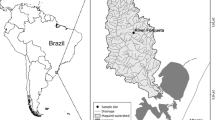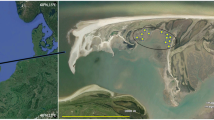Summary
We examined microhabitat use in Barbus graellsii, Barbus haasi, Chondrostoma toxostoma, Rutilus arcasii, and Salmo gairdneri over a 19 month period in the upper Rio Matarraña, Spain. B. graellsii and Ch. toxostoma exhibited non-random microhabitat use during all seasons and preferentially occupied deep microhabitats with heterogeneous substrates. During the majority of seasons in which they were present, B. haasi and R. arcasii occurred in microhabitats similar to those occupied by B. graellsii and Ch. toxostoma. S. gairdneri was over-represented in high velocity microhabitats with erosional substrates. We did not observe any evidence of interspecific interference competition or avoidance. Substrate composition did not appear to affect microhabitat use outside of its covariation with depth and velocity. Seaonal variation in microhabitat use by B. graellsii, B. haasi and Ch. toxostoma was strongly correlated with seasonal changes in microhabitat availability. S. gairdneri, however, occurred closer to the substrate when average velocities were high. Larger B. graellsii and B. haasi sometimes occupied deeper, higher velocity microhabitats than did smaller specimens. Larger B. graellsii also occasionally occurred farther from shelter than did smaller specimens; the reverse was true for B. haasi. Larger Ch. toxostoma sometimes were found farther from both the substrate and shelter than smaller individuals, whereas smaller specimens occasionally inhabited deeper areas with more depositional substrates than did larger Ch. toxostoma. During Late Summer 1985, smaller Ch. toxostoma also occupied microhabitats with higher velocities than did larger specimens. A comparison of microhabitat use for two species present in both upper and lower portions of the Matarraña indicated that most differences in microhabitat use could be attributed to inter-site differences in microhabitat availability. The data suggest, hovever, that both species shifted to more protected microhabitats in the higher velocity site. Assemblage members generally occupied statistically distinguishable microhabitats and could be classified as: 1) high-velocity upper water column (S. gairdneri), 2) low velocity lower water column (B. graellsii, Ch. toxostoma and R. arcasii), and 3) shelter-oriented benthic (B. haasi). The introduction of S. gairdneri during Winter 1984 did not produce microhabitat shifts in any of the native species. Whether or not the native species affected microhabitat use in S. gairdneri is unknown. Interspecific competition for space, however, did not appear to strongly influence microhabitat use among the native species.
Similar content being viewed by others
References
Grossman GD, Freeman MC (1987) Microhabitat use in a stream fish assemblage. J Zool 212:151–176
Grossman GD, Moyle PB, Whitaker JO Jr (1982) Stochasticity in structural and functional characteristics of an Indiana stream fish assemblage: a test of community theory. Am Nat 120:423–454
Grossman GD, Freeman MC, Moyle PB, Whitaker JO Jr (1985) Stochasticity and assemblage organization in an Indiana stream fish assemblage. Am Nat 126:275–285
Grossman GD, Sostoa A de, Freeman MC, Lobon-Cerviá J (1987) Microhabitat use in a mediterranean riverine fish assemblage. Fishes of the lower Matarraña. Oecologia (Berlin) 73:490–500
Jenkins TM Jr (1969) Social structure, position choice and microdistribution of two trout species (Salmo trutta and Salmo gairdneri) resident in mountain streams. Anim Behav Monogr 2:57–123
Li HW (1975) Competition and coexistence in stream fishes. In: Moyle PB, Koch D (eds) Trout/non-game fish relationships in streams. Center for Water Resources Research, University of Nevada, Reno. pp 19–30
Maitland PS (1977) Freshwater fishes of Britain and Europe. Hamlyn, London
Mills CA, Mann RHK (1985) Environmentally-induced fluctuations in year-class strength and their implications for management. J Fish Biol 27A:209–226
Moyle PB, Senanayaka R (1984) Resource partitioning among the fishes of a rain forest stream in Sri Lanka. J Zool 202:195–223
Slaney PA, Northcote TG (1974) Effects of prey abundance on density and territorial behavior of young rainbow trout (Salmo gairdneri) in laboratory stream channels. J Fish Res Board Canada 31:1201–1209
Wheeler A (1969) The fishes of the British Isles and Northwest Europe. MacMillan, London
Author information
Authors and Affiliations
Rights and permissions
About this article
Cite this article
Grossman, G.D., de Sostoa, A., Freeman, M.C. et al. Microhabitat use in a mediterranean riverine fish assemblage. Oecologia 73, 501–512 (1987). https://doi.org/10.1007/BF00379407
Received:
Issue Date:
DOI: https://doi.org/10.1007/BF00379407




